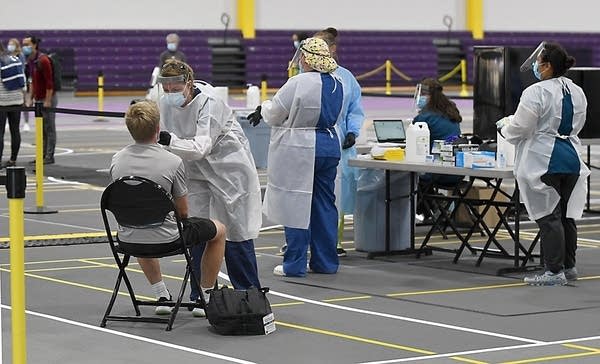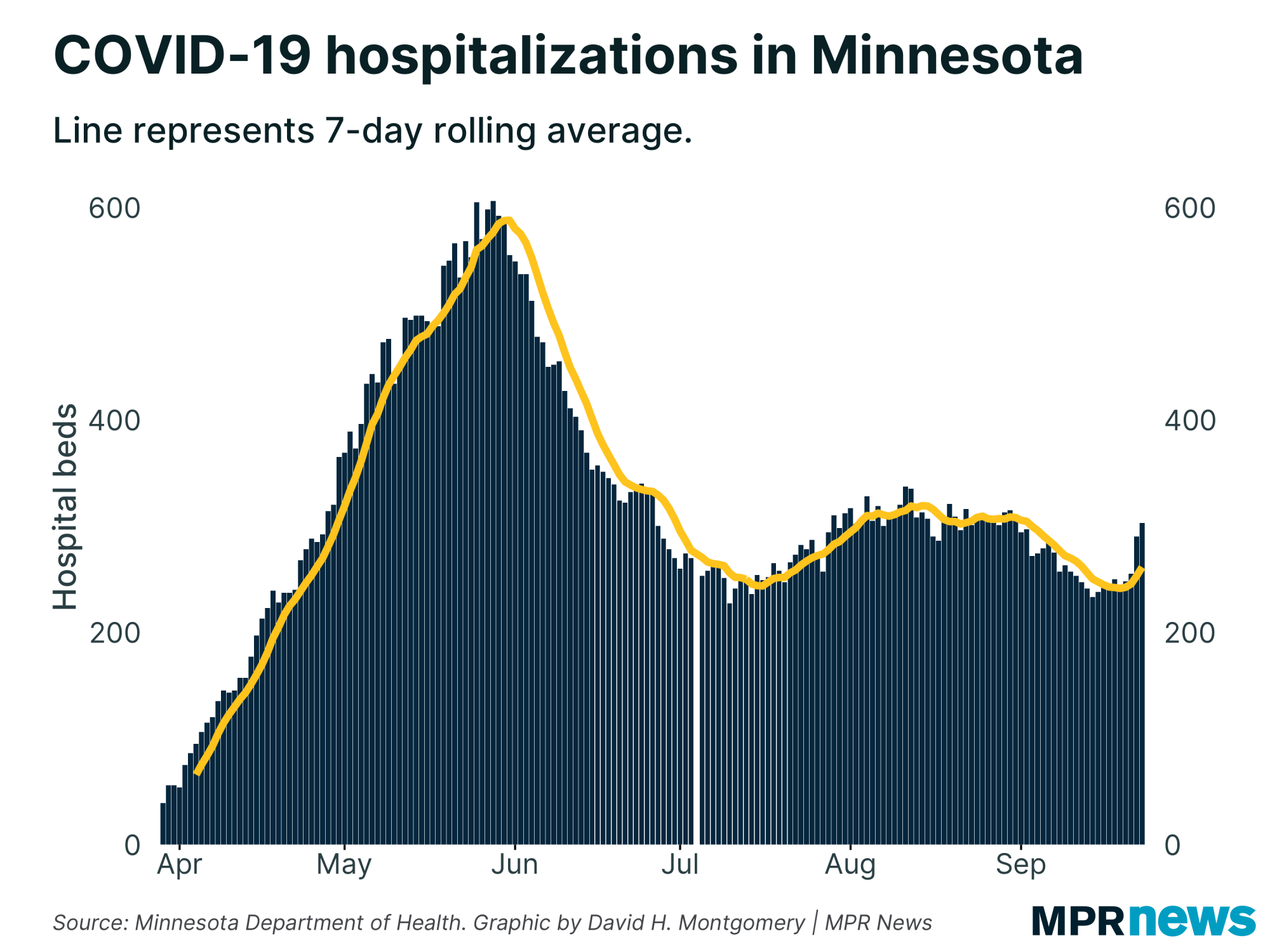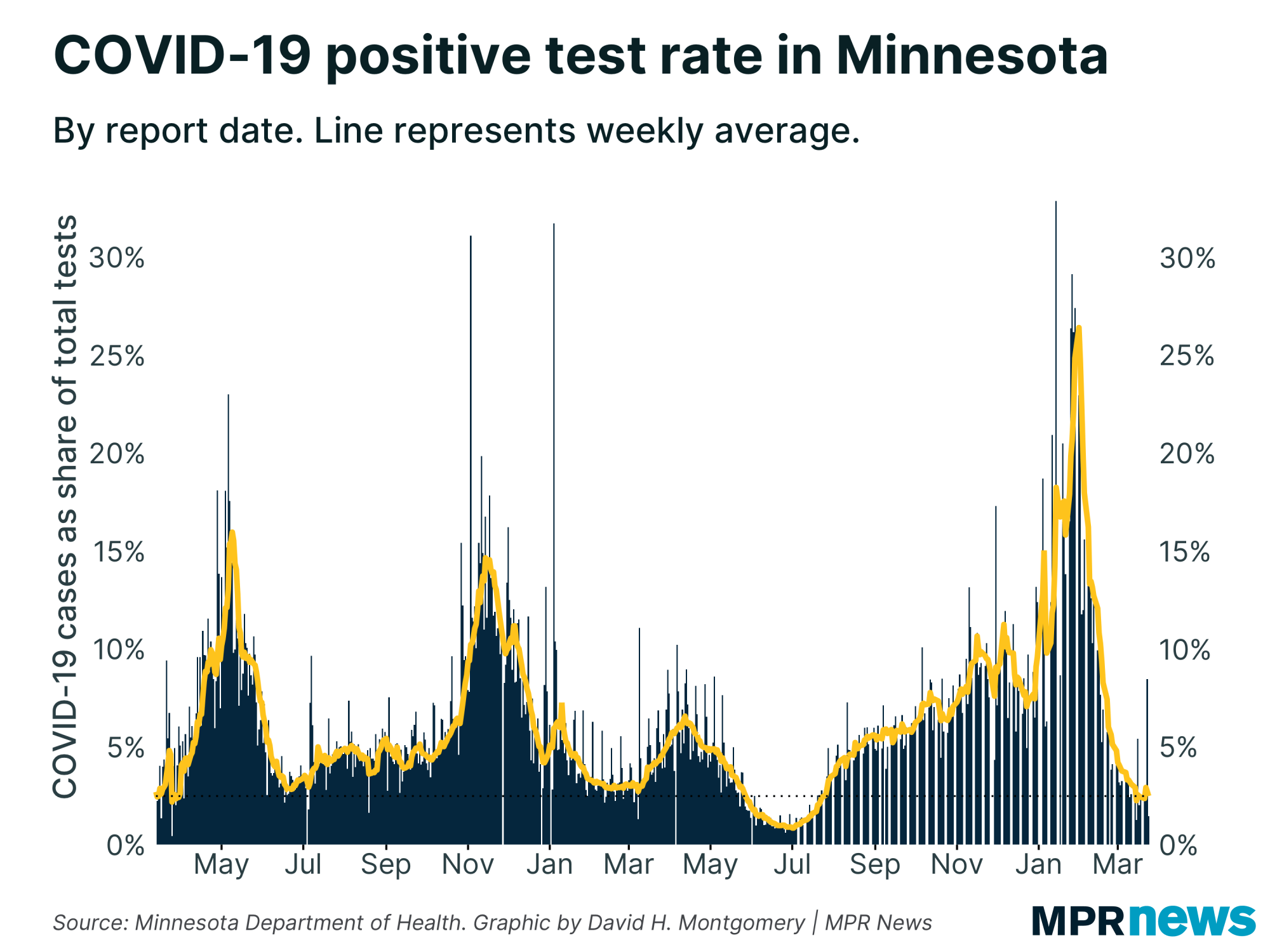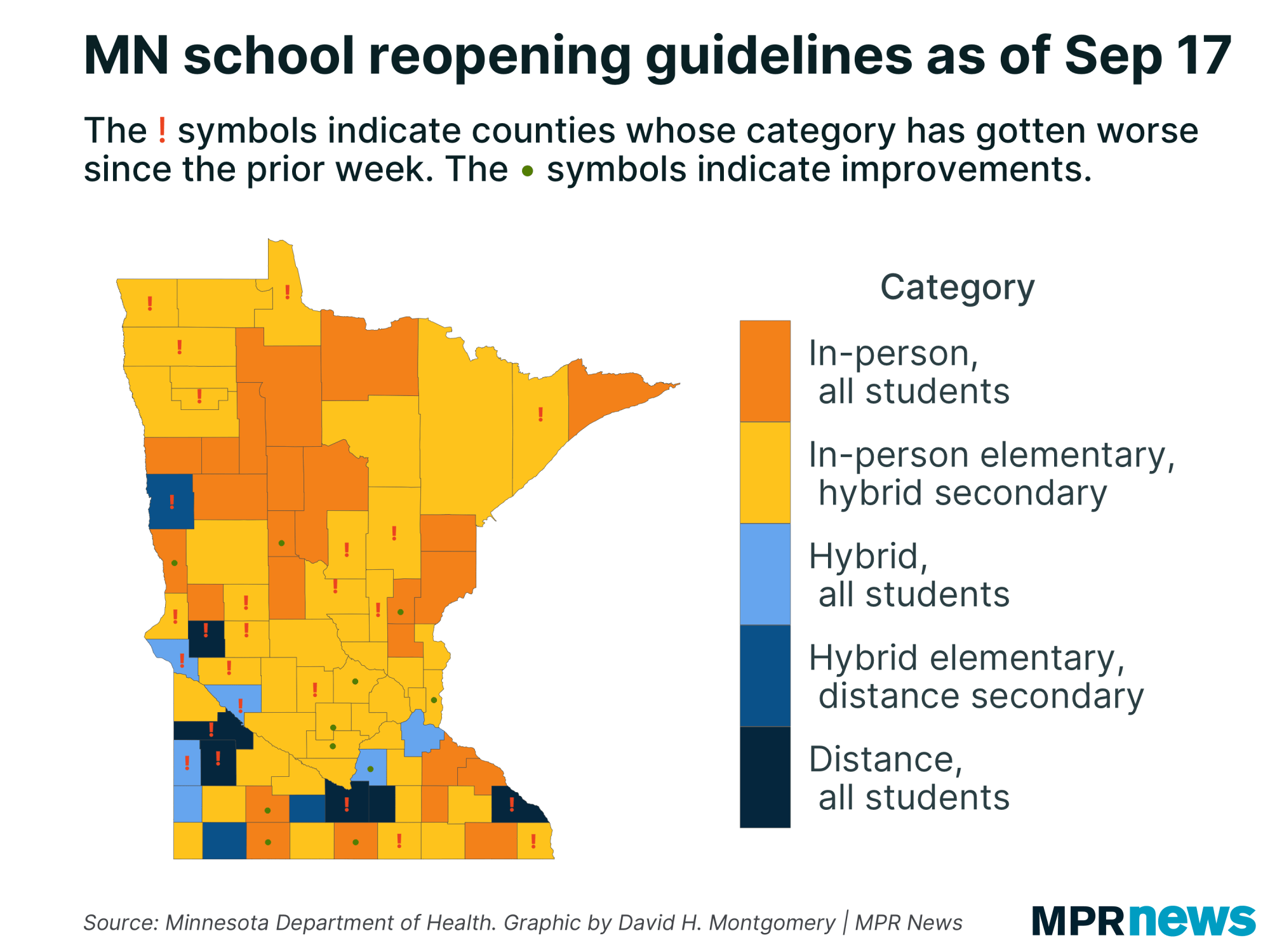Sept. 19 update on COVID-19 in MN: 924 newly confirmed cases, 13 deaths

Go Deeper.
Create an account or log in to save stories.
Like this?
Thanks for liking this story! We have added it to a list of your favorite stories.
Updated: 11:45 a.m.
Minnesota health officials reported 924 newly confirmed COVID-19 cases on Saturday, along with 13 deaths as the overall death toll approaches 2,000.
The state has now seen more than 900 newly reported cases for a third consecutive day — the first time that’s happened in Minnesota during the pandemic. It follows a stretch of relatively moderate new daily caseloads. But much of the increase is explained by expanded testing: Minnesota has seen more than 20,000 new tests for three consecutive days, also the first time that’s happened in Minnesota this pandemic.
On Friday the Health Department reported nearly 1,100 new confirmed infections in Minnesota, from nearly 27,000 tests. Health officials didn’t brief reporters Friday, so it wasn’t immediately clear why the case numbers and test results have jumped so steeply.
On some past high-count days, the department has explained it as the product of a reporting backlog and there was some evidence of that. Winona State University authorities on Friday noted most of the 100 Winona County infections tallied in Friday’s Health Department report were “old cases” surfacing due to a lag in reporting from past testing.
Turn Up Your Support
MPR News helps you turn down the noise and build shared understanding. Turn up your support for this public resource and keep trusted journalism accessible to all.

Saturday’s 13 newly reported deaths include eight people who were residents of long-term care facilities.
The number of people hospitalized with COVID-19 in Minnesota, and the number of those patients in ICUs, dropped slightly in Saturday's report.
Here are Minnesota’s current COVID-19 statistics:
1,963 deaths (13 new)
88,721 confirmed cases (924 new); 80,407 off isolation
241 still hospitalized, 134 in ICUs
1,815,774 tests, 1,291,395 people tested
‘We do not want that to happen here’
As it works to get Minnesotans to stay vigilant about COVID-19 and its spread, the Health Department is rolling out a monthlong push to boost testing in selected regions around the state to curb community spread of the coronavirus.
The agency is “deeply concerned” about the jump in community spread across Minnesota — cases where people don’t know how they contracted the disease, Dan Huff, an assistant state health commissioner, said earlier this week as he explained the need to boost testing efforts.

Minnesota is seeing cases leap in neighboring states, he added, and “we do not want that to happen here.”
Officials are also pushing ahead on education and enforcement efforts to ensure restaurant owners and patrons comply with the state’s masking and social distancing orders.

Huff added that investigators want compliance in the “most unobtrusive way possible” but that owners and customers had a responsibility to follow the rules.
“This is a serious disease. We know that,” he said. “There’s no vaccine. There’s no cure, and it’s contagious. Everyone needs to do their part.”
‘This is not a cold’
Among their worries this week, health officials have also expressed unease about the possible resumption of football and other fall sports in the pandemic.
Minnesota has seen more than 1,400 cases of COVID-19 tied to sports activities in the pandemic, including nearly 900 in adults. Collectively, that caseload has led to recommended quarantines for more than 3,300 people.

“This is not a cold,” Dr. Ruth Lynfield, the state’s epidemiologist, warned of COVID-19. “There are some people who do fine with this, but there are others, including young people, who do not do fine.”
She noted studies showing heart and other health problems linked to COVID-19 that appear to linger beyond the infection.
“We really don’t have a sense of all the things this virus can do,” she said.
The Big Ten intends to open its season Oct. 23-24. The Minnesota State High School League expects to meet on Monday to review its earlier decision to not play football and volleyball this fall in the face of COVID-19.
While youth and college sports are important, COVID-19 poses a risk to student athletes as well as to the universe of coaches, friends and families that surround players, top state health officials said.
The Health Department was “watching with concern” the rapid growth in new COVID-19 confirmed cases in the states surrounding Minnesota and bracing for potential higher daily case counts from over the Labor Day weekend, when people ventured out for informal get-togethers with family and friends, Health Commissioner Jan Malcolm said earlier this week.

The state saw a jump in cases following the July Fourth holiday. Officials also worry about a one-two punch this fall and winter from COVID-19 and the typical flu season.
On Thursday, Malcolm and Kris Ehresmann, the state’s infectious disease director, said it will take about two more weeks to determine if Labor Day gatherings led to a surge in cases.
Health Department investigators this week are also going door-to-door in randomly selected neighborhoods in the Twin Cities and southeastern Minnesota as part of a statewide study to find out where COVID-19 is more prevalent.
They’ll ask questions about where people spend time, whether anyone in the house has been diagnosed with COVID-19, and what information they'd like about the virus. They'll also offer free nasal swabs and serology tests.
College campus worries rise
People in their 20s make up the age bracket with the state’s largest number of confirmed cases — topping 20,000 since the pandemic began, including more than 11,500 infections among people ages 20-24.
The numbers help explain why experts remain particularly concerned about young adults as spreaders of the virus.
While less likely to feel the worst effects of the disease, experts worry youth and young adults will spread it to grandparents and other vulnerable populations and could also hamper attempts to reopen campuses completely to in-person teaching.

They’ve been driving the recent outbreaks, although the number of high school-age children confirmed with the disease has also grown, with more than 8,100 total cases among children 15 to 19 years old since the pandemic began.
Winona State University is in the middle of a 14-day campus quarantine that will limit all nonessential activities on campus to slow the spread of COVID-19. Winona State on Wednesday reported a current total of 125 active positive cases and 294 since late August.
Regionally, southern and central Minnesota and the Twin Cities suburbs have driven much of the increase in new cases while Hennepin and Ramsey counties show some of the slowest case growth in the state.

Hot spots have included southwestern Minnesota, where 75 cases have been traced to a late-August wedding in Lyon County that officials describe now as the state’s largest single social spreader event.
On Monday, Minnesota officials also confirmed an outbreak of 122 cases at the federal women’s prison in Waseca, which they said began when federal authorities transferred people into the facility from outside the state who had COVID-19.
Developments around the state
Virus spread shifts the school guidance map
The evolving COVID-19 pandemic in Minnesota continues to change school reopening recommendations around the state.
The most recent batch of recommendations, released Thursday, cover cases from Aug. 23 to Sept. 5 — a period that happened to see a late-August spike in new COVID-19 cases.
The result? A full 25 counties saw their COVID-19 case counts slip past one of the Health Department’s thresholds, changing their recommendation toward more distance learning for more students.

In the most recent update, six counties are recommended to have all students do full-time distance learning: Blue Earth, Lyon, Stevens, Waseca, Winona and Yellow Medicine counties. All but Waseca County were previously recommended to allow at least some in-person learning.
Not every county got worse. Eleven counties saw their case rates improve compared to last week’s results, and saw their recommendation shift to more in-person learning.
Overall, 24 largely rural counties have a recommendation of in-person for all students.
A formula produced by the Health Department generates the guidance for districts to help decide whether to have in-person learning, distance learning, or a mix, based on the rate of COVID-19 cases in that district’s county over a two-week period.
These recommendations are only considered the starting point for school districts, which make their own learning plans in cooperation with the Health Department.

Minnesota’s yo-yoing COVID-19 case numbers in recent weeks have meant some drastic swings in school districts’ safe learning recommendations, but state health officials say they’re taking the data irregularities into account when working with schools to set learning plans.
Because Minnesota’s calculation uses weeks-old data and calculates cases by the day a person got tested rather than the day the tests were reported, this update is not affected by recent reporting delays caused by the Labor Day weekend.
— David H. Montgomery | MPR News
Mayo Clinic introduces new coronavirus tracking tool
Mayo Clinic has launched a new COVID-19 case tracker. The online tool will breakdown coronavirus cases by county across 50 states and Washington, D.C.
The tool is aimed at helping people see emerging hot spots — information that can inform decisions about travel, and the safety of friends and family.
The tool includes total cases in each county and state, but also new cases, positive test rates, fatality rates and overall trends.
The data behind the new site is based on Mayo Clinic's own internal COVID-19 modeling tool, which it has used to predict how and where the virus will spread.
— Catharine Richert | MPR News
Top headlines
Election Day voting in Minnesota starts now: Election administrators, political party leaders and campaign officials suspect a lot of voters will cast ballots early this year. The ongoing coronavirus pandemic still has people jittery about standing in lines.
Statewide testing push seeks to stem COVID-19 transmission: State health officials are launching a monthlong statewide testing effort aimed to stem transmission of the virus. The pop-up testing clinics will start the week of Sept. 21 and testing is free and available to anyone, including those who don’t have insurance.
COVID-19 in Minnesota
Data in these graphs are based on the Minnesota Department of Health's cumulative totals released at 11 a.m. daily. You can find more detailed statistics on COVID-19 at the Health Department website.


